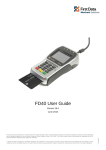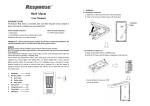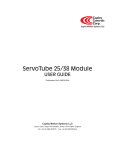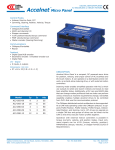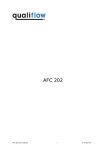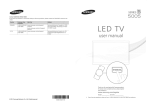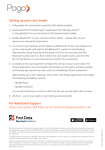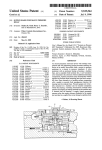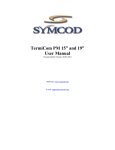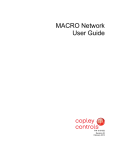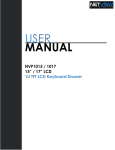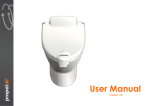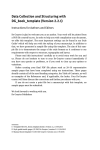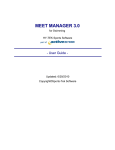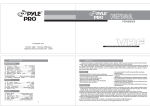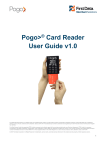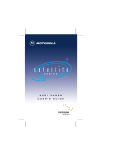Download ServoTube 11.indd
Transcript
ServoTube 11 INSTALLATION GUIDE Publication Ref: UM03015/A Copley Motion Systems LLC Luckyn Lane, Pipps Hill, Basildon, Essex SS14 3BW England Tel: +44 (0)1268 287070 Fax +44 (0)1268 293344 Prelims ServoTube 11 Installation Guide WARRANTY Copley Motion Systems guarantees its equipment against faulty components for a period of twelve months from delivery. Replacement components will be free of charge. Copley Motion Systems shall not in any event be liable for consequential damage or loss. Copley Motion Systems operates a customer care facility and all requests for repair and replacement should be directed to the Customer Care Department. The serial number of the equipment should be quoted in any communications. The right to change specification and price is reserved by Copley Motion Systems. DISCLAIMER Copley Motion Systems makes no guarantees of any kind with regard to this manual. Copley Motion Systems shall not be liable for errors contained herein or for consequential or incidental damages incurred as a result of acting on information contained in the manual. CUSTOMER CARE For enquiries relating to the operation and use of the ServoTube 11 described in this Manual please contact the Customer Care Helpdesk, Telephone : +44 (0)1268 287070. Copley Motion Systems LLC Luckyn Lane, Pipps Hill, Basildon, Essex SS14 3BW England Tel: +44 (0)1268 287070 Fax: +44 (0)1268 293344 (c) Copley Motion Systems 2007 INTERNATIONAL CONTACT DETAILS website: http//www.copleycontrols.com Page (ii) World Headquarters, USA Copley Controls Corp. 20 Dan Road, Canton, MA 02021 USA European Headquarters Copley Motion Systems LLC Luckyn Lane, Pipps Hill, Basildon, Essex SS14 3BW England Tel: +1 781 828 8090 Fax: +1 781 828 1750 Tel: +44 (0)1268 287070 Fax: +44 (0)1268 293344 ServoTube 11 Installation Guide Prelims ServoTube 11 INSTALLATION GUIDE Contents Preliminary pages Title page .................................................................................................................... (i) Copyright notice / disclaimer...................................................................................... (ii) Contents list (this page) ............................................................................................ (iii) Warnings .................................................................................................................. (iv) Cautions..................................................................................................................... (v) Reader’s Notes ......................................................................................................... (vi) Abbreviations ........................................................................................................... (vii) Chapters 1 Overview ................................................................................................................ 1 2 Installation.............................................................................................................. 3 3 Maintenance .......................................................................................................... 9 4 Service ................................................................................................................. 13 Appendices A Glossary of terms & Abbreviations....................................................................... 17 B Trouble Shooting.................................................................................................. 19 C Technical Specification ........................................................................................ 20 Page (iii) Prelims ServoTube 11 Installation Guide WARNINGS Warning symbols and meanings In this User Manual warning symbols are used. These are intended to alert you to the potential hazards to personnel which are associated with the equipment described, in all aspects of use, including handling, installation, operation and maintenance. Heart pacemakers. Personnel fitted with pacemakers must not handle or work on this equipment. Strong magnets. The thrust rod contains powerful magnets and will strongly attract ferrous objects. Damage can occur to computer disks and credit cards. Electric shock. Potentially lethal voltages may be present during the commissioning and servicing of this equipment. Isolate and disconnect all sources of electrical supply before working on the equipment. Particular care needs to be taken when working on or around motor phase connections. Hot surface. Surface temperatures of up to 80 °C can be present during the commissioning and servicing of this equipment. Allow the forcer and thrust rod to cool before working on the equipment. Crush hazard. The forcer may move unexpectedly. Always isolate all sources of electrical supply before working on the equipment. General hazard. Follow the advice given. Electrical safety This equipment must be earthed. EMC precautions This equipment is intended for use in a light industrial environment. It is recommended that the following precautions be observed during installation: Keep all cable lengths to a minimum. Provide as much physical separation as possible between power and signal cables. In particular, avoid long, parallel runs of cables. Maintain screen continuity throughout the cable run. Use 360 degree screen terminations where possible. “Pig-tail” terminations are not recommended. It is the responsibility of the User to ensure compliance with any local electrical and EMC regulations in force at the time of installation. Page (iv) ServoTube 11 Installation Guide Prelims READER’S NOTES GENERAL This manual describes the Installation, Maintenance and Spares of the ServoTube 11 linear motor. ASSOCIATED PUBLICATIONS The following publications are associated with the ServoTube 11 User Manual. Title Reference Number STA Data sheet DS01097 STB Data sheet DS01098 Accelnet Micro Panel User Guide - Accelnet Micro Panel Data Sheet - Page (v) Prelims Page (vi) ServoTube 11 Installation Guide Chapter 1 Overview ServoTube 11 Installation Guide Chapter 1 Product Overview SERVOTUBE 11 ACTUATOR SERVOTUBE 11 COMPONENT The ServoTube Actuator is an optimal solution for industrial position control. Faster than a ballscrew with the clean reliability of a linear forcer, ServoTube is a cost-effective alternative to air cylinders in applications requiring greater flexibility and control. ServoTube delivers the speed of a belt-drive system with the clean reliability of a linear forcer at a price unprecedented in the industry. Familiar form factor, integral position feedback and large air gap make installation simple. The ServoTube Actuator incorporates an IP67 rated forcer and a sealed stainless steel thrust rod enclosing rare-earth magnets. Four models deliver a continuous force range of 9~27 N (2~6 lb) with peak forces up to 92 N (21 lb). 11 stroke lengths are available from 14~271 mm. The ServoTube forcer components consist of an IP67 rated forcer and a sealed stainless steel thrust rod enclosing rare-earth magnets. Four models deliver a continuous force range of 9~27 N (2~6 lb) with peak forces up to 92 N (21 lb). A range of Thrust Rods are available for travel lengths up to 372mm. The patented magnetic design of ServoTube generates 12 micron (0.47 mil) repeatability and 350 micron (14 mil) accuracy from a non-contact, integral position sensor. No external encoder is required. Position output is industry standard 1V pk-pk sin/cos signals. The patented magnetic design of ServoTube generates 12 micron (0.47 mil) repeatability and 350 micron (14 mil) accuracy from a non-contact, integral position sensor. No external encoder is required. Position output is industry standard 1V pk-pk sin/cos signals. An internal dry bearing provides clean, quiet, maintenance-free performance. Life expectancy far exceeds typical ballscrew solutions. ServoTube is an ideal OEM solution for easy integration into pick-and-place gantries and general purpose material handling machines. The load is mounted directly to the Forcer typically supported by a single bearing rail. The Thrust Rod is mounted at both ends, similar to a ballscrew. A large air gap reduces alignment constraints. The ServoTube Actuator is ideal for push/pull/lift material handling, packaging and automated assembly applications. ServoTube accepts a range of industry standard accesories for simple mechanical integration. Flexible mid-stroke position control is simple with Accelnet - a matched, self-tuning indexer complete with plug-and-play cabling. Simply select your ServoTube model number and the system comes up tuned and ready to run. Clear diagnostics make system commissioning easy. Fill in the blanks to define position, velocity and acceleration. Accelnet interfaces easily to PLCs and features CANopen network connectivity. The tubular forcer has superior thermal efficiency, radiating heat uniformly. High duty cycles are possible without the need for forcer-air or water cooling. ServoTube is complimented by a range of matched, self-tuning servo-amplifiers and indexers complete with plug-and-play cabling. Amplifiers interface easily to PLC’s and feature CANopen network connectivity for distributed control applications. Page 1 Chapter 1 Overview Page 2 ServoTube 11 Installation Guide Chapter 2 Installation ServoTube 11 Installation Guide Chapter 2 Installation UNPACKING • Check packaging for signs of damage. • Metal surfaces may be hot or below 0oC following prolonged storage. • Remove packaging. Do not discard. In the event of items requiring return, it is recommended that the original packaging be used. • Ensure that the delivery note correctly reflects your order and the items delivered. • Check equipment for signs of damage. Never use the equipment if it appears damaged in any way. • Read the User Guide before installing and using this equipment. INSTALLATION Intended operating environment This equipment is intended for use in an environment within the following conditions: Operating temperature 0 to +40 °C Storage temperature -25 to +70 °C Ingress Protection IP67 Altitude (above mean sea level) 1000 m Overvoltage category II Pollution degree 2 EMC light industrial Page 3 Chapter 2 Installation ServoTube 11 Installation Guide Mechanical - STA The outline drawing of the STA is shown in Figure 2.1. It comprises the forcer with integrated plastic bearings and the thrust rod. The integrated bearings act as a guide for the moving thrust rod. It is not intended to withstand side loading. If side loading is expected then it is advised that an external bearing is fitted. The STA forcer can be mounted by two methods. • Using the single M20 end fixing. • Using the M3 clearance or M4 threaded fixings on the forcer body (4 off or 8 off depending on the forcer type). IMPORTANT When using the end flange fixing method, the fixings and mounting plate must be of a non- ferrous material such as aluminium, stainless steel, and plastic for example. In addition, when two STAs are mounted side-by-side, they should be isolated by a minimum of 1 mm thick mild steel plate to prevent interaction. See Figure 2.1 1 mm mild steel Figure 2.1 Side-by-side mounting of STAs must be separated by a 1 mm thick mild steel plate Dimensional details for both are given in Figure 2.2. The recommended tightening torque for the fixings are: M20 end fixing 4 Nm M4 2 Nm (both non lubricated i.e. no thread lock) The thrust rod has optional male and female threaded connections at each end. These are intended to interface to a number of standard accessories. Page 4 Chapter 2 Installation ServoTube 11 Installation Guide 124.1 15.0 22.9 AF ACTUATOR ENVELOPE = (2 x STROKE) + 151.6 35 1.5 MIN (SEE NOTE 1) M20x1.5p THREAD 20.5 40.8 61 58.5 STA1104 M20x1.5p PLASTIC NUT = 68.4 = BEARING M4 TAPPED HOLE, THRU (OR 3.3, M3 CLEARANCE) 4 POSN 18.0 28.0 +0.102 11.11 +0.032 (7/16") 9.0 ±0.1 0.3 A MTG HOLE M5x8DP 35 1.5 MIN ACTUATOR ENVELOPE = (2 x STROKE) + 202.8 5.0 15.0 THRUST ROD 7.0 ±0.2 175.3 (SEE NOTE 1) M20x1.5p THREAD A STA1108 5.0 M20x1.5p PLASTIC NUT 86.9 M4 TAPPED HOLE, THRU (OR 3.3, M3 CLEARANCE) 4 POSN 18.0 226.5 15.0 OVERALL LENGTH 1mm (See Table) 0.3 A 9.0 ±0.1 END COLLAR DETAIL SCALE 1:1 35 1.5 MIN ACTIVE LENGTH 1mm (See Table) 7.0 ±0.2 10.0 8.0 AF ACTUATOR ENVELOPE = (2 x STROKE) + 254.0 (SEE NOTE 1) M20x1.5p THREAD STA1112 M20x1.5p PLASTIC NUT 86.9 18.0 170.8 18.0 M4 TAPPED HOLE, THRU (OR 3.3, M3 CLEARANCE) 8 POSN 277.4 15.0 35 1.5 MIN (SEE NOTE 1) 7.5 M20x1.5p THREAD 17.5 0.000 11.0 - 0.043 ACTUATOR ENVELOPE = (2 x STROKE) + 304.9 STA1116 M5 THREAD M20x1.5p PLASTIC NUT 8.0 AF 86.9 M4 TAPPED HOLE, THRU (OR 3.3, M3 CLEARANCE) 8 POSN 18.0 221.7 ALL DIMENSIONS IN mm 18.0 Note 1: Actuator is double acting Tolerance 2mm Figure 2.1 STA outline drawings and mounting details Page 5 Chapter 2 Installation ServoTube 11 Installation Guide Mechanical - STB The outline drawing of the STB is shown in Figure 2.2. It comprises the forcer and the thrust rod. With the addition of thrust rod supports and a linear bearing, a moving forcer solution can be implemented. Mounting holes are provided on the forcer body that are tapped M4 and clearance for M3. Dimensional details are shown in Figure 2.2. The recommended tightening torque for the fixings are: M4 bearing to forcer 2 Nm All torque figures are non-lubricated i.e. no thread lock. As the STB has a moving forcer it is supplied with highly flexible cables suitable for continuous flexing operation In order to achieve the best reliability and life from these cables it is advised that some form of cable management system is used. Typically, this will be an energy chain mounted parallel to the direction of motion. Always follow the manufacturers recommendations when installing cables into energy chains. In particular: • Observe cable minimum bend radius requirements (see Appendices). • Never allow the cable to be under tension within the energy chain. • Physically separate cables within the energy chain to prevent premature failure due to abrasion. • Never cross cables within the energy chain. • Be careful to prevent the cable from twisting or becoming kinked during installation into the energy chain. Page 6 Chapter 2 Installation ServoTube 11 Installation Guide 124.0 15.0 35 1.5 MIN M20x1.5p THREAD 11.6 0.3mm NOMINAL AIR GAP 40.8 = 35.0 = 20.5 = M20x1.5p PLASTIC NUT = 28.0 68.4 M4 TAPPED HOLE, THRU (OR 3.3, M3 CLEARANCE) 4 POSN 18.0 175.2 15.0 35 1.5 MIN M20x1.5p THREAD = 35.0 = STB1108 M20x1.5p PLASTIC NUT LENGTH OF THRUST ROD 86.9 M4 TAPPED HOLE, THRU (OR 3.3, M3 CLEARANCE) 4 POSN 18.0 226.4 15.0 35 1.5 MIN M20x1.5p THREAD 35.0 = STB1112 = M20x1.5p PLASTIC NUT 86.9 18.0 18.0 170.8 11.0 M4 TAPPED HOLE, THRU (OR 3.3, M3 CLEARANCE) 8 POSN 0.000 - 0.043 277.3 15.0 35 1.5 MIN THRUST ROD M20x1.5p THREAD 35.0 = STB1116 = 61 58.5 STB1104 M20x1.5p PLASTIC NUT ALL DIMENSIONS IN mm 86.9 M4 TAPPED HOLE, THRU (OR 3.3, M3 CLEARANCE) 8 POSN 18.0 221.7 18.0 Figure 2.2 STB outline drawings and mounting details Page 7 Chapter 2 Installation ServoTube 11 Installation Guide Electrical All electrical connections to the STA and STB are made via two cables, see Figure 2.3. One carries power to the forcer and the other carries signals from the position sensor. These cables are supplied either pre-terminated for a specific drive or with flying leads. Where they are pre-terminated, simply plug the cables into the relevant connectors on the drive. FORCER POWER POSITION SENSOR CONNECTOR REFERENCE CONNECTOR REFERENCE J2 J4 AMPLIFIER Copley Accelnet Micro Panel WARNING THE THRUST ROD ON BOTH STA AND STB MUST BE EARTHED. THIS CAN BE ACHIEVED BY EARTHING THE CONNECTED MECHANICAL PARTS ON THE USER’S MACHINE. ACCELNET MICRO PANEL J5 D-TYPE CONNECTOR SENSOR CABLE J1 TO J4 TO J2 J2 POWER CABLE J3 J4 Figure 2.3 - Schematic showing connection of STA / STB to the Accelnet Micro Panel Amplifier For cables other than those supplied, a connector lock insert kit is available that allows standard D-connector screws to be used. These replace the connector retaining clip and simply snap into either side of the forcer. Page 8 Chapter 3 Maintenance ServoTube 11 Installation Guide Chapter 3 Maintenance WARNING ISOLATE AND DISCONNECT ALL SOURCES OF ELECTRICAL SUPPLY BEFORE WORKING ON THE EQUIPMENT. PREVENTATIVE STA The STA is low maintenance and as such requires only minimal periodic inspection. The integral bearing is dry running, requiring no lubrication. Periodically: • Check that the thrust rod can move freely over the entire stroke. • Clean any accumulated debris from the thrust rod surface (ferrous material, in particular, can be attracted to the thrust rod surface). • Check all fixings are tight and secure. STB The STB is low maintenance and as such requires only minimal periodic inspection. Where an external linear bearing is used, please consult the bearing manufacturer for recommendations on lubrication types and lubrication intervals. Periodically: • Check that the forcer can move freely over the entire stroke. • Clean any accumulated debris from the thrust rod surface (ferrous material, in particular, can be attracted to the thrust rod surface). • Check all fixings are tight and secure. • Check all flexing cables for signs of wear or damage. Page 9 Chapter 3 Maintenance ServoTube 11 Installation Guide CORRECTIVE MAINTENANCE CABLE REPLACEMENT This procedure applies to both STA and STB versions. If a cable needs to be replaced it will be necessary to change the complete cable assembly. Removal • Disconnect the cable assembly from the Accelnet Micro Panel Amplifier. • Release the D-type connector retaining clip as shown in Figure 3.1. • Unplug the connector and remove the cable assembly. CONNECTOR RETAINING CLIP LIFT CLIP OFF HOOK APPLY PRESSURE TO RELEASE CLIP FROM HOOK LIFT AWAY THE CONNECTOR RETAINING CLIP EXISTING CABLE ASSEMBLY HOOK UNPUG EXISTING CABLE ASSEMBLY Figure 3.1 (left) Removing the retaining clip and (right) removing the cable assembly. Replacement • Plug the 15-pin D-type plug into the connector on the forcer and engage the connector retaining clip as shown in Figure 3.2. PLUG IN NEW CABLE ASSEMBLY APPLY PRESSURE HERE TO ENGAGE CLIP ON HOOK Figure 3.2 (left) Plugging in the new cable assembly and (right) fitting the retaining clip. Page 10 Chapter 3 Maintenance ServoTube 11 Installation Guide BEARING REPLACEMENT This procedure applies only to the STA version. There are two replaceable bearings, located one at each end of the housing. Removal • Withdraw the thrust rod away from the end containing the bearing to be replaced until the thrust rod disengages from the bearing, see Figure 3.3. SLIDE THRUST ROD TO THIS POSITION BEARING BEING REPLACED SLIDE THRUST ROD TO THIS POSITION BEARING BEING REPLACED Figure 3.3 Positioning the thrust rod when removing a bearing. • Use a small flat-blade screwdriver or similar, and rotate the spherical bearing through 90 degrees so that it aligns with the slot in the housing, see Figure 3.4. • Push the thrust rod back into the housing until the rotated bearing is pushed out at the other end. FRONT BEARING IN-LINE FRONT BEARING ROTATED PUSH REAR BEARING IN-LINE REAR BEARING ROTATED PUSH Figure 3.4 Setting the orientation of the front (left) and rear (right) spherical bearings. Replacement • Insert the bearing in the slot in the housing and push down gently. It will be in the rotated position shown in Figure 3.4. • Use a small screwdriver to rotate the bearing through 90 degrees until it is in the in-line position as shown in Figure 3.4. • Re-insert the thrust rod. Page 11 Chapter 3 Maintenance Page 12 ServoTube 11 Installation Guide Chapter 4 Service ServoTube 11 Installation Guide Chapter 4 Service SERVICE Should you need to return any items to Copley Motion Systems, before doing so, please call our Sales coordinator on +44 (0)1268 287070 or send a fax to +44 (0)1268 293344 in order to obtain an RMA (Returned Materials Authorisation) number. The RMA number should then be quoted on all items returned and quoted for all enquiries. Please note that when returning items it is recommended that the original packaging be used. SPARES The available spares for the STA and STB are listed in Tables 4.1 and Table 4.2. Table 4.1 Cables avaialable: terminated for Accelnet Micro Panel and with flying leads Description Accelnet Micro Panel Flying leads Cable length = 3m 180 475 123 450 480 143 Cable length = 5m 180 475 125 450 480 145 Cable length = 3m 180 475 133 450 480 153 Cable length = 5m 180 475 135 450 480 155 Non-flexing cables Flexing cables Table 4.2 Hardware Description Order Code STA Polymer Bearing (kit of 2) 401 000 001 M20 plastic nut 150 583 056 Connector retaining clip 400 046 446 Connector lock inserts (kit of 2) 401 000 002 To place an order for spare parts please telephone or fax your order to the Sales co-ordinator: Tel: +44 (0)1268 287070 Fax: +44 (0)1268 293344 Page 13 Chapter 4 Service Page 14 ServoTube 11 Installation Guide Appendices ServoTube 11 Installation Guide Appendices CONTENTS APPENDIX A - GLOSSARY OF TERMS & ABBREVIATIONS APPENDIX B - TROUBLE SHOOTING APPENDIX C - TECHNICAL SPECIFICATION Page 15 Appendices Page 16 ServoTube 11 Installation Guide Appendices ServoTube 11 Installation Guide Appendix A Glossary of Terms & Abbreviations GLOSSARY OF TERMS TERM DESCRIPTION OF TERM Peak force Peak force is the force produced when the peak current is applied to the motor. It is the product of Force constant (N/Apk) and Peak current (Apk). The motor is not moving, there is no forced cooling and no additional heat-sinking. The duration of the peak force is thermally limited and is therefore only allowable for a period of 1 second. Continuous stall force Continuous stall force is the force produced when the continuous current is applied to the motor. It is the product : Force constant (N/Apk) x Continuous stall current (Apk) or : Force constant (N/Arms) x Continuous stall current (Arms). The motor is not moving and there is no forced cooling. It is quoted with and without the addition of a 25 x 25 x 2.5 cm heatsink plate mounted with thermal grease to the mounting surface of the motor. Peak current Peak current is the current required to heat the motor phases to their maximum operating temperature when the ambient temperature is 25°C, the motor is not moving, there is no forced cooling and no additional heat-sinking. It is the maximum allowable current before demagnetisation of the magnets occurs when the magnet temperature is 100°C. The duration of the peak current is thermally limited and is therefore only allowable for a period of 1 second. Continuous stall current Continuous stall current is the current required to heat the motor phases to their maximum operating temperature when the ambient temperature is 25°C, the motor is not moving and there is no forced cooling. It is quoted with and without the addition of a 25 x 25 x 2.5 cm heatsink plate mounted with thermal grease to the mounting surface of the motor. Force constant Force constant is the peak force produced when 1 ampere (peak) flows into one phase and 0.5 ampere (peak) flows out of the remaining two phases (as in sinusoidal commutation) quoted in N/Apk. Alternatively, it is the peak force produced when 0.707 ampere (rms) flows into one phase and 0.353 ampere (rms) flows out of the remaining two phases (again as in sinusoidal commutation) quoted in N/Arms. Back EMF Back EMF constant is the peak phase to phase voltage generated when the motor is travelling at a velocity of 1m/s. Fundamental motor Fundamental motor constant is the continuous stall force divided by the square root of the constant power dissipated in the motor at that continuous stall force. Eddy current loss Eddy current loss is the amount of opposing force produced by the motor when it is travelling at a velocity of 1m/s. Sleeve clogging force Sleeve clogging force is the amount of force variation produced by having an iron sleeve. The variation is independant of motor current. Resistance Resistance is measured phase to phase at temperatures of 25°C and 100°C. Inductance Inductance is measured phase to phase at a frequency of 1 kHz. The actual value of inductance varies as the motor position varies so it is the minimum value that is quoted. Page 17 Appendices ServoTube 11 Installation Guide Electrical time constant Electrical time constant is the time taken for a step current input to the motor to reach 63.2% of its value. Continuous working Continuous working voltage is the maximum allowable continuous voltage between any two voltage motor phases or between any motor phase and the motor safety earth. Pole pitch Pole pitch is the distance in millimetres for one complete electrical cycle (between like magnetic poles). Power dissipation Power dissipation is the maximum power that can be dissipated by the motor when the motor phases are at their maximum operating temperature, the ambient temperature is 25°C, the motor is not moving and there is no forced cooling. It is quoted with and without the addition of a 25 x 25 x 2.5cm heatsink plate mounted with thermal grease to the mounting surface of the motor. Maximum phase Maximum phase temperature is the maximum operating temperature for the motor phases. It is temperature limited to provide a safe operating temperature for the magnets. Rthphase-houslng Rthphase-houslng is the temperature rise from the motor housing to the motor phases for an input power of 1 watt to the motor. The motor is not moving, there is no forced cooling and no additional heatsinking. Rthhousing-ambient Rthhousing-ambient is the temperature rise from ambient temperature to the motor housing for an input power of 1 watt to the motor. The motor is not moving and there is no forced cooling. It is quoted with and without the addition of a 25 x 25 x 2.5cm heatsink plate mounted with thermal grease to the mounting surface of the motor. Thermal time constant Thermal time constant is the time taken for the motor phases to cool to 36.8% of the difference between motor phase and ambient temperatures when there is no current flowing, the motor is not moving there is no forced cooling and no additional heatsinking. ABBREVIATIONS The abbreviations used in this Guide are listed in the following table. Apk Ampere peak PCB Printed circuit board Arms Ampere root mean square PUR Polyurethane AWG American Wire Gauge PVC Poly Vinyl Chloride COS cosine s second d.c. direct current SIN sine EMC Electro-Magnetic Compatibility TYP Typical EMF Electro-Motive Force UL Underwriters Laboratory kg kilogramme V Volt m metre Vpk Volt peak mA milliampere Vpk-pk Volt peak to peak mH millihenry Vrms Volt root mean square mm millimetre W Watt MTG Mounting °C degrees Celsius N Newton mm micrometre (micron) PTC Positive Temperature Coefficient Page 18 Appendices ServoTube 11 Installation Guide Appendix B Troubleshooting TROUBLESHOOTING CHART Check to see if the problem you are experiencing is listed in the chart below. If the problem cannot be solved with reference to this chart, contact the customer services department. Fault Possible cause Action Forcer/thrust rod fails to move and produces no force. 1. Drive not powered. 1. Apply power to drive. 2. Forcer phase connections not made. 2. Check forcer phase connections on drive. 3. Forcer over-temperature sensor not connected. 3. Check forcer over-temperature sensor connections on drive. 4. Forcer over-temperature. 4. Allow forcer to cool. 1. One or more motor phase connections not made or made incorrectly. 1. Check forcer phase connections on drive. 2. One or more position sensor connections not made or made incorrectly. 2. Check position sensor connections on drive. 3. Forcer/thrust rod mechanically blocked. 3. Check forcer/thrust rod is free to move. Forcer/thrust rod moves but is jerky in motion. Incorrect pole pitch set up or phase offset between position sensor and forcer back emf. Check drive or controller set up. Forcer/thrust rod moves in wrong direction. One or more position sensor and forcer phase connections made incorrectly. Check position sensor and forcer phase connections on drive. Forcer/thrust rod fails to move but does produce force. Page 19 Appendices ServoTube 11 Installation Guide Appendix C Technical Datasheet ELECTRICAL SPECIFICATIONS FORCER TYPE 1104 1108 1112 1116 Units Peak force @ 25 C ambient for 1 sec 46.0 53.0 68.9 91.9 N 12 12 12 12 Apk Continuous stall force @ 25oC ambient (1) 9.27 15.78 21.44 26.75 N Continuous stall current @ 25 C ambient 1.71 2.52 2.64 2.47 Arms 2.41 3.56 3.74 3.50 Apk Continuous stall force @ 25oC ambient (1) 6.02 10.83 15.18 19.28 N Continuous stall current @ 25 C ambient 1.11 1.73 1.87 1.78 Arms 1.58 2.45 2.64 2.52 Apk 5.42 6.26 8.12 10.83 N/Arms o Peak current @ 25oC ambient for 1 sec With 25 x 25 x 2.5 cm heatsink plate o Without heatsink plate o Force constant (sine commutation) 3.83 4.42 5.74 7.66 N/Apk Back EMF constant (phase to phase) 4.42 5.10 6.63 8.84 Vpk/m/s Fundamental motor constant 1.75 2.49 3.05 3.52 N/√W Eddy current loss 0.38 0.76 1.14 1.52 N/m/s Resistance @ 25 C (phase to phase) 4.90 3.27 3.68 4.91 Ohm o Resistance @ 100 C (phase to phase) 6.32 4.29 4.74 6.31 Ohm Inductance @ 1kHz (phase to phase) 1.15 0.99 0.87 1.15 mH Electrical time constant 0.23 0.23 0.23 0.23 ms 75 75 75 75 V d.c. 25.6 25.6 25.6 25.6 mm o Maximum working voltage Pole pitch (one electrical cycle) 407 359 378 422 m/s2 Maximum speed (3) (STA) 5.3 5.6 5.4 4.7 m/s Peak acceleration (4) (STB) 155 119 109 120 m/s2 Maximum speed (5) (STB) 5.2 5.2 3.9 3.1 m/s Peak acceleration (2) (STA) Notes (1) Reduce continuous stall force to 89% at 40°C ambient. (2) Based on a moving thrust rod with 14 mm stroke and no payload. (3) Based on a moving thrust rod with triangular move over maximum stroke and no payload. (4) Based on a moving forcer with typical bearings and no payload. (5) Based on a moving forcer with triangular move over maximum stroke and no payload. Page 20 Appendices ServoTube 11 Installation Guide THERMAL SPECIFICATIONS MOTOR TYPE 1104 1108 1112 1116 Units Maximum phase temperature 100 100 100 100 Thermal resistance Rthphase-housing 1.48 0.72 0.47 0.35 Power dissipation @ 25oC ambient 27.6 40.1 49.7 58.0 Watt Thermal resistance Rthhousing-ambient 1.24 1.15 1.04 0.94 o Power dissipation @ 25oC ambient 11.8 18.9 24.8 30.0 Watt Thermal resistance Rthhousing-ambient 4.88 3.24 2.55 2.15 o Thermal time constant 142 176 202 223 s 1104 1108 1112 1116 Units 245 245 271 271 mm o o C C/W With 25 x 25 x 2.5 cm heatsink plate C/W Without heatsink plate C/W MECHANICAL SPECIFICATIONS FORCER TYPE Maximum stroke (STA) Maximum stroke (STB) 240 390 520 650 mm Forcer mass (excluding thrust rod and cable) 188 375 563 750 gram Thrust rod mass/metre 0.68 0.68 0.68 0.68 kg/m Integrated bearing type (STA only) 2 x plastic polymer, self-lubricating, self-aligning - POSITION SENSOR The position sensor outputs analogue, differential sine and cosine signals for providing position feedback. Figure C.1 shows the relationships between forcer phase back EMF and position sensor outputs for one direction of motion (as shown by arrows in Figures C.1 and C.2). Page 21 Appendices ServoTube 11 Installation Guide Phase V Phase U Phase W 1104, 1112,1116 Neutral Back EMF (phase to neutral) Phase U Phase W Phase V 1108 only Neutral -SIN +SIN +2.75V +2.50V +2.25V Sensor signals (all models) +COS -COS +2.75V +2.50V +2.25V 0 30 60 90 120 150 180 210 240 270 300 330 360 electrical degrees Figure C.1- The relationships between motor phase back EMF and position sensor outputs Figure C.2 - Arrows indicate direction of motion SPECIFICATION VALUE UNITS Output signal period 25.6 mm 1 Vpk-pk Signal amplitude (between +/- signals) Output current ±10 mA Supply voltage 5 ± 0.25 V d.c. Supply current (output current =0) 32 ± 5 mA 8 mm Position Repeatability (2) ±12 mm Absolute Accuracy ±350 mm/m Resolution (1) (3) Notes (1) Dependent on amplifier. (2) Dependent on amplifier. Under constant operating conditions. Self-heating of the forcer will cause expansion in the thrust rod by the motor will cause expansion in the thrust rod during the initial warm up period. In high duty applications (corresponding to an internal forcer temperature of 80°C) a 0.5 metre thrust rod will expand typically by 125 microns. (3) Maximum error over 0.5 metre under constant operating conditions. Page 22 Appendices ServoTube 11 Installation Guide MOTOR OVER TEMPERATURE SENSOR It is strongly recommended that the forcer over-temperature sensor is connected to the drive amplifier or servo controller at all times in order to reduce the risk of damage to the forcer due to excessive temperatures. Protection is provided by three, positive temperature coefficient (PTC) thermistors embedded in the forcer phases. As the forcer phase temperature approaches 100°C, the PTC thermistors exhibit a sharp increase in electrical resistance. This change in resistance can be detected by circuitry within the drive amplifier or servo controller and used to reduce or disable the output of the drive amplifier in order to protect the forcer. SPECIFICATION VALUE UNITS Resistance at 25oC 235 to 705 Ohms Resistance at 95 C 4,700 Ohms Resistance at 100 C 10,000 Ohms 32 Vd.c. o o Maximum continuous voltage CABLE OPTIONS The ServoTube 11 has a cable assembly that comprises power and sensor cables with a 15-way high density D-sub female connector for direct connection to the forcer. There are two cable types available. Both cable types are available in 3 metre or 5 metre lengths. Option S cables are flexible but are not intended for continuous flex or energy chain applications. OPTION ‘S’ SPECIFICATION POWER SENSOR Overall diameter (nominal) 5.3 mm 6.5 mm PVC PVC 4 4 x twisted pair 0.34mm (22 AWG) 0.14mm2 (26AWG) Screened Screened 27mm 33mm -30oC to +70oC -30oC to +70oC Outer jacket material Number of conductors Size of conductors Screened / Unscreened 2 Minimum bending radius-fixed routing Operating temperature-fixed routing Option R cables are suitable for continuous flex or energy chain applications.cables are standard on the STB. OPTION ‘R’ SPECIFICATION Overall diameter (nominal) POWER SENSOR 4.7 mm 5.8 mm PUR PUR 4 4 x twisted pair 0.34mm2 (22 AWG) 0.14mm2 (26AWG) Screened Screened Outer jacket material Number of conductors Size of conductors Screened / Unscreened Minimum bending radius - flexible routing 36mm 44mm Operating temperature - flexible routing -40 C to +90 C -40 C to +90oC Operating temperature - flxed routing -50oC to +90oC -50oC to +90oC o o o Page 23 Appendices ServoTube 11 Installation Guide FORCER ELECTRICAL CONNECTIONS All connections to the forcer are made using the cable assembly supplied. This is terminated with a high-density 15-pin D-type female which mates with the connector on rear of the forcer pod as shown in Figure C.3. The connector is held secure by the retaining clip arrangment. D-TYPE SOCKET RETAINING CLIP D-TYPE PLUG HOOK SENSOR CABLE D-TYPE MALE 1 6 11 POWER CABLE Figure C.3 Shows connecting the cable assembly to the forcer and connector details The pinout details for this connector is shown below. FUNCTION +SIN Pin 1 -SIN Pin 2 +COS Pin 3 -COS Pin 4 +5Vd.c. Pin 5 0V Pin 6 +TH (Thermistor) Pin 7 -TH (Thermistor) Pin 8 Factory use only Pin 9 Factory use only Pin 10 No connection Pin 11 Earth (forcer body) Pin 12 Forcer phase U Pin 13 Forcer phase V Pin 14 Forcer phase W Pin 15 SCREEN Page 24 15-PIN D-TYPE Connector body 5 10 15 Appendices ServoTube 11 Installation Guide CABLE TERMINATIONS The ServoTube 11 cable is available with two termination options. • Option F has the wire ends stripped and solder tinned ready for termination. • Option C is terminated with connectors that plug directly into a Copley Accelnet Micro Panel amplifier (ACJ-S). The connections for both options are shown in the table below. FUNCTION F-FLYING LEADS C-ACCELNET MICRO PANEL Sensor Amplifier connection NA J4 Connector type NC Samtec IPD1-07-D +SIN Blue J4, pin 8 -SIN Red J4, pin 1 +COS White J4, pin 9 -COS Brown J4, pin 2 +5Vd.c. Yellow J4, pin 4 0V Green J4, pin 11 +TH (Thermistor) Pink J4, pin 7 -TH (Thermistor) Grey J4, pin 6 SCREEN J4, pin 14 Amplifier connection NA J2 Connector type NC Molex 39-01-4051 Forcer phase U Yellow J2, pin 4 Forcer phase V White J2, pin 3 Forcer phase W Brown J2, pin 2 Green J2, pin 1 J2, pin 1 SCREEN Power Earth (forcer body) SCREEN SCREEN Page 25 Appendices ServoTube 11 Installation Guide ENVIRONMENT The ServoTube 11 is intended for use in an environment within the following conditions defined in the table below. SPECIFICATION Operating temperature Storage temperature Ingress protection Altitude (above mean sea level) VALUE 0oC to +40oC -25oC to +70oC IP67 1000m Overvoltage category II Pollution degree 2 EMC Light industrial In addition In addition, the ServoTube 11 is available with two environmental coating options. Option S has the forcer body coated with a 25 micron layer of black anodise that is suitable for general use. Option H has the forcer body coated with a 90 micron layer of hard natural anodise that is suitable for harsher environments. Page 26 ServoTube 11 Installation Guide Page 27 Copley Controls Corp Copley Motion Systems LLC Luckyn Lane, Pipps Hill, Basildon, Essex SS14 3BW England Tel: +44 (0)1268 287070 Fax +44 (0)1268 293344 Ref: UM03015/A


































